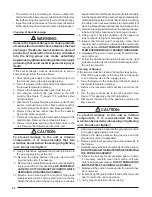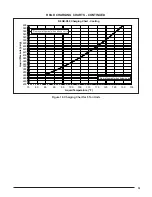
18
START UP AND ADJUSTMENTS
Pre-Start Check List
Verify the unit is level and allows condensate to drain.
Verify all clearance requirements are met and there is
free airfl ow to and from the outdoor coil.
Verify that the duct work is sealed to prevent air leakage.
Verify that the line voltage power leads are securely
connected and the unit is properly grounded.
Verify that the low voltage wires are securely connected
to the correct leads in the low voltage area of the control
box.
Verify that the gas line service pressure does not exceed
10.0 inches WC (0.36 psig), and is not less than 4.5
inches WC (0.16 psig) for natural gas. For LP gas the
line service pressure must not exceed 14 inches WC
(0.51 psig) and must not be less than 11.0 inches WC
(0.40 psig).
Verify that the fl ame roll-out control is closed. If necessary,
press the red button to reset the control. DO NOT install
a jumper wire across the control to defeat its function.
If the control reopens upon start-up, DO NOT reset
the control without identifying and correcting the fault
condition which caused the control to trip.
Verify that the gas line has been purged and all
connections are leak tight.
Verify that all exterior panels are replaced and securely
fastened.
Verify that the outdoor fan turns freely.
Verify that the power supply branch circuit overcurrent
protection is sized properly.
Verify that the thermostat is wired correctly. The
thermostat function switch should be set to OFF and
the thermostat fan switch should be set to AUTO.
Start-Up Procedure
WARNING:
If this unit is equipped with crankcase heaters,
allow 24 hrs for heating of the refrigerant
compressor crankcase prior to start up or anytime
the power has been removed for more than 12
hrs. Failure to comply may result in damage or
cause premature failure of the system.
• Check all electrical wiring for loose connections and
tighten as required.
• Check unit for return air fi lters and condensate trap.
• Close all electrical disconnects to energize the system.
Air Circulation
Leave the thermostat system mode on OFF, and set the
fan mode to ON. Blower should run continuously. Check
the air delivery at the supply registers and adjust register
openings for balanced air distribution. Examine ductwork
for leaks or obstruction if insuffi cient air is detected. Set
the thermostat fan mode to AUTO. The blower should
stop running.
System Cooling
1. Set the thermostat’s system mode to COOL and the
fan mode to AUTO. Gradually lower the thermostat
temperature setpoint below room temperature and verify
the compressor, fan and indoor blower energize.
2. Feel the air being circulated by the indoor blower and
verify that it is cooler than ambient temperature. Listen for
any unusual noises. If unusual sounds occur, determine
the source of the noise and correct as necessary.
3. Allow the cooling system to operate for several minutes
and then set the temperature selector above room
temperature. Verify the fan and compressor cycle off
with the thermostat. NOTE: The blower will also stop
after an 85 - 90 second delay.
System Heating
1. Set the thermostat to the lowest setting.
2. Follow the procedures given on the operating instruction
label, this manual or attached inside the louvered control
access panel.
3. Set the thermostat above room temperature and verify
the Operating Sequence. See page 20.
4. Verify that the compressor and outdoor fan motor are
not energized.
5. After the unit has run for approximately fi ve minutes,
set the thermostat below room temperature and verify
the shutdown sequence; steps 10 -12 in the Operating
Sequence section (page 20).
Verifying and Adjusting Temperature Rise
Verify the temperature rise through the unit is within the
range specifi ed on the unit data label. Temperature rises
outside the specifi ed range could result in premature heat
exchanger failure.
1. Place thermometers in the return and supply air stream
as close to the unit as possible. The thermometer on the
supply air side must be shielded against direct radiation
from the heat exchanger to avoid false readings.
2. Adjust all registers and duct dampers to the desired
position. Run the unit for 10 to 15 minutes before
taking any temperature readings. The temperature
rise is the difference between the supply and return
air temperatures.
NOTE: For typical duct systems, the temperature rise will
fall within the range specifi ed on the data label (with the
blower speed at the factory recommended setting) shown
in Table 10 (page 25). If the measured temperature rise falls
outside the specifi ed range, it may be necessary to change
the blower speed. Lowering the blower speed increases
the temperature rise and a higher speed decreases the
temperature rise.
The unit is equipped with a variable speed motor. Speed
selection is made by moving the leads on the blower motor
terminal block. The speed taps for adjusting the motor
speed are shown in the unit wiring diagram or Figures 12
& 13 (pages 28 - 29). Refer to the Blower Speed Section
(page 15) for additional information.
















































